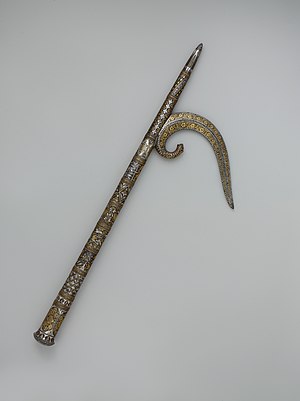Bullhooks: Difference between revisions
mNo edit summary |
|||
| (2 intermediate revisions by 2 users not shown) | |||
| Line 1: | Line 1: | ||
[[File:Elephant Goad MET DP231148.jpg|alt=Bullhook|thumb|Bullhook]] | [[File:Elephant Goad MET DP231148.jpg|alt=Bullhook|thumb|Bullhook]] | ||
Bullhooks are tools used to control of elephants, particularly in the entertainment and tourism industries. Also known as elephant hooks, ankuses, or goads, they are designed to prod, poke, and direct elephants by applying pressure to sensitive areas of their skin, such as the ears, mouth, or feet. | '''Bullhooks''' are tools used to control of elephants, particularly in the entertainment and tourism industries. Also known as elephant hooks, ankuses, or goads, they are designed to prod, poke, and direct elephants by applying pressure to sensitive areas of their skin, such as the ears, mouth, or feet. | ||
The use of bullhooks in elephant training is based on the principles of negative reinforcement, where the elephant is punished for unwanted behavior through the application of pain or discomfort. When an elephant exhibits undesirable behavior, such as refusing to obey commands or exhibiting aggression, the handler will use the bullhook to jab or strike the animal in sensitive areas such as the ears, trunk, or feet. This painful stimulus is intended to deter the animal from repeating the unwanted behavior in the future. | The use of bullhooks in elephant training is based on the principles of negative reinforcement, where the elephant is punished for unwanted behavior through the application of pain or discomfort. When an elephant exhibits undesirable behavior, such as refusing to obey commands or exhibiting aggression, the handler will use the bullhook to jab or strike the animal in sensitive areas such as the ears, trunk, or feet. This painful stimulus is intended to deter the animal from repeating the unwanted behavior in the future. | ||
| Line 14: | Line 13: | ||
*[[Elephant tourism]] | *[[Elephant tourism]] | ||
*[[Phajaan]] | *[[Phajaan]] | ||
*[[List of | *[[List of captive elephants]] | ||
*{{See also/elephant}} | |||
[[Category:Elephants]] | [[Category:Elephants]] | ||
Latest revision as of 20:26, 12 February 2024

Bullhooks are tools used to control of elephants, particularly in the entertainment and tourism industries. Also known as elephant hooks, ankuses, or goads, they are designed to prod, poke, and direct elephants by applying pressure to sensitive areas of their skin, such as the ears, mouth, or feet.
The use of bullhooks in elephant training is based on the principles of negative reinforcement, where the elephant is punished for unwanted behavior through the application of pain or discomfort. When an elephant exhibits undesirable behavior, such as refusing to obey commands or exhibiting aggression, the handler will use the bullhook to jab or strike the animal in sensitive areas such as the ears, trunk, or feet. This painful stimulus is intended to deter the animal from repeating the unwanted behavior in the future.
Bullhooks are inhumane and can cause physical and psychological harm to elephants, leading to stress, anxiety, and aggressive behavior.
One of the primary concerns with bullhooks is their potential to inflict pain and injury. Due to the size and strength of elephants, trainers often rely on the use of sharp and pointed bullhooks to exert control and discipline. This can result in lacerations, bruises, and puncture wounds, which can be extremely painful and take a long time to heal.
The use of bullhooks can cause elephants to experience fear, anxiety, and stress, which can manifest in aggressive behavior towards humans and other elephants.
